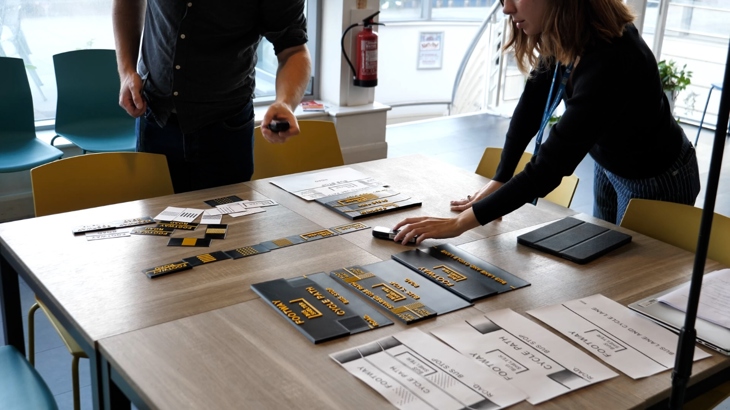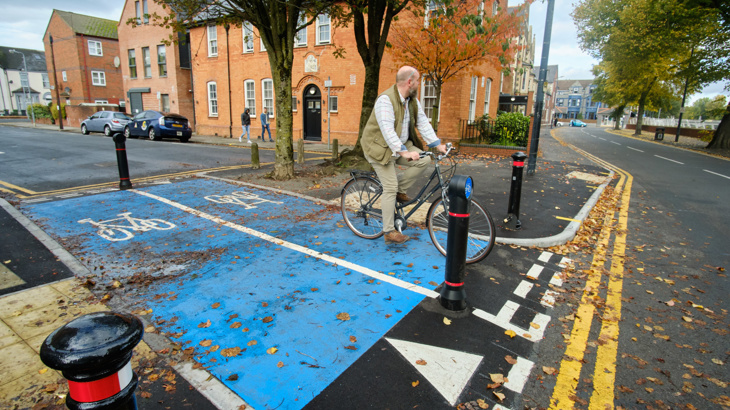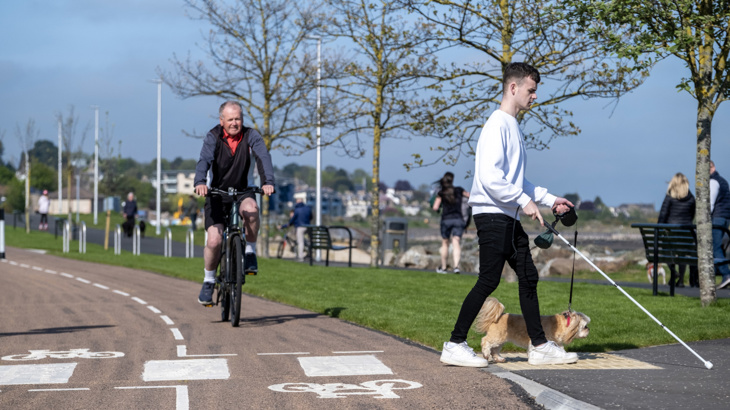A recent pilot project in collaboration with the Assistive Technologies Innovation Centre, University of Wales Trinity Saint David, has looked at new ways of engaging people with visual impairments by exploring the use of 3D printing and tactile maps to support independent travel and navigation in Wales. The use of tactile maps could enable vital input from people with visual impairments when it comes to designing active travel routes.

ATiC researchers setting up the pilot study with tactile models. Credit: ATiC\University of Wales Trinity St David
Sustrans and the Assistive Technologies Innovation Centre (ATiC) collaborated on a project which could change engagement for people with visual impairments.
The project explored a range of manufacturing technologies, including 3D printing, to develop tactile maps, which enabled people with visual impairments to experience and feedback on suggested urban design plans.
The pilot study was made possible through the £24m Accelerate Wales programme, led by Life Sciences Hub Wales, and co-funded by the European Regional Development Fund through Welsh Government.
Collaborative working that empowers people
The three-month pilot study involved people with visual impairments from the outset, with members of Vision Impaired West Glamorgan evaluating tactile maps, including 3D-printed maps, of different active travel designs.
These maps were made using different manufacturing processes to identify how best to communicate urban design features to people with visual impairments.
One of the aims of the research was also to engage people with visual impairments to have a better understanding of active travel plans that would affect them the most.
The pilot study also sought to make active travel decision-making more inclusive, while promoting new and innovative best practice in community engagement.
Making an impact in the visually impaired community
Andrea Gordon, Chair of Vision Impaired West Glamorgan, said:
“Vision impaired people are often prevented from contributing to the development of active travel routes because plans are not provided in accessible formats.
“The Equality Act 2010 requires local authorities to engage with disabled residents, but we need to find an easier way to explain proposals.
“The design of our streets and the built environment has a huge impact on the safety and independence of vision impaired people, so active travel can make getting out and about much easier, or much harder.
“Tactile maps can be part of the solution when active travel routes are designed with inclusion in mind from the start.”

An example of where active travel and tactile paving meet on a popular route. Credit: photojB/Sustrans
Innovations that promote active travel for everyone
The results of the pilot study found that the use of tactile maps was useful in engaging people with visual impairments to provide feedback on more diverse, inclusive, and safer urban designs.
“Preliminary research by ATiC and Sustrans Cymru indicated there was potential to develop small-scale, high-contrast 3D tactile maps to communicate best designer intentionality,” said Yolanda Rendón Guerrero, ATiC Innovation Fellow.
“For this pilot study, the team focused on evaluating various tactile maps of bus bi-passes and routes shared with cyclists to identify their effectiveness as a consultation medium.
“Our research team then provided testing capabilities at our state-of-the-art facilities to evaluate and measure the performance of the characteristics of various tactile maps and their usability with visually impaired participants, with the support of Vision Impaired West Glamorgan.
“The outcomes of this pilot study indicated a need for further research to better understand the benefits of high-contrast tactile maps as a consultation medium.”

The use of tactile maps could enable vital input from people with visual impairments. Credit: Alan McAteer/Sustrans
Tim John, an Active Travel Design Advisor who initiated the approach of developing 2D designs of active travel infrastructure into tactile maps, led on the development of the original designs for 3D printing.
Tim designed digital tactile maps of active travel infrastructure based on Welsh Government’s Active Travel Design Guidance.
Using these designs, ATiC then researched and refined them for different manufacturing processes, to realise prototypes of tactile maps, before testing them with members of Vision Impaired West Glamorgan.
Tim, who has worked extensively in the active travel sector in Wales, said: “Through developing active travel routes which are fully inclusive, it will assist in unlocking the maximum potential for modal shift.
“The tactile map tool will enable a user group often not included in the design process to have a say on the development of the built environment.
“Whilst the benefits to this group is reason enough to develop new engagement practices, the benefits of fully inclusive designs extend to all users, whether young or old, parents moving with children or people with limited mobility.”
Ensuring designs account for marginalised groups
“There are over 110,000 people in Wales who live with some kind of visual impairment,” said Ryland Jones, Head of Connected Communities at Sustrans Cymru.
“To ensure people with visual impairments can fully engage with new design proposals, which are truly fit-for-purpose, printed 3D models can offer an interactive medium for people to interpret through touch.
“This means that those who are the most affected by urban design decisions can now have an immediate experience of what’s being suggested.”





